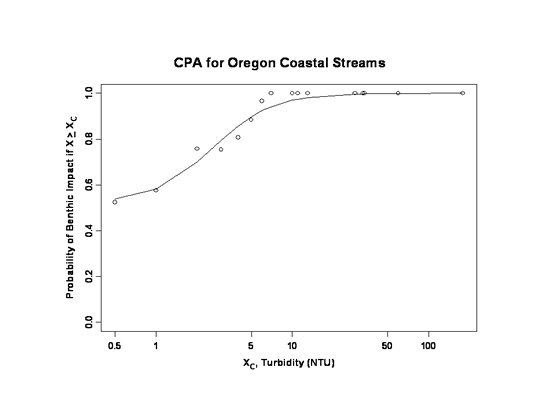Conditional Probability Analysis: EPT Taxa Richness < 18 vs. Turbidity in Oregon Coastal Streams

Plot
- Analysis: Conditional probability analysis
- Independent variable: Turbidity (NTU)
- Dependent variable: Probability of unacceptable condition for EPA taxa richness at < 18
- Key: symbols = observations, solid line: nonlinear curve fit of logistic-like function with change in slope.
- Sample size: n = 49
Model
- Conditional probability analysis does not produce model parameters. Rather, it plots the probabilities of observing the stated impairment (i.e. item 3 in the list above) over a stressor intensity gradient.
- Date: 8 November 2006
Data Analysis
- Program: S-Plus Version 7.0, user written scripts, variable weighting for site data
Data Origin
- Agency: U.S. Environmental Protection Agency
- Program: Environmental Monitoring and Assessment Program (EMAP), Regional EMAP (REMAP)
- Project: REMAP Region 10 Washington/Oregon Coastal Streams and Yakima River Basin Streams Project
- Location: Washington & Oregon coastal and Yakima River Basin
- Environmental Monitoring and Assessment Program (EMAP) data and metadata.
Sampling Design
- Data collected 1994 through 1995.
- Chaloud, D.J. and D.V. Peck. 1994. Environmental Monitoring and Assessment Program - Surface Waters: Integrated Quality Assurance Project Plan for the Surface Waters Resource Group, 1994 Activities. EPA 600/X-91/080, Rev. 2.00. U.S. Environmental Protection Agency, Office of Research and Development, Las Vegas, NV 89193.
- Hayslip, G. A. (editor). 1993. EPA Region 10 In-stream Biological Monitoring Handbook (for wadeable streams in the Pacific Northwest). EPA-910/9-92-013. U. S. Environmental Protection Agency - Region 10, Environmental Services Division, Seattle, WA 98101.
- Catalog Documentation for REMAP Region 10. 1994-1995 Washington/Oregon Coastal Streams and Yakima River Basin Streams Project Data.
Contact
John F. Paul, paul.john@epa.gov, (919) 541-3160
